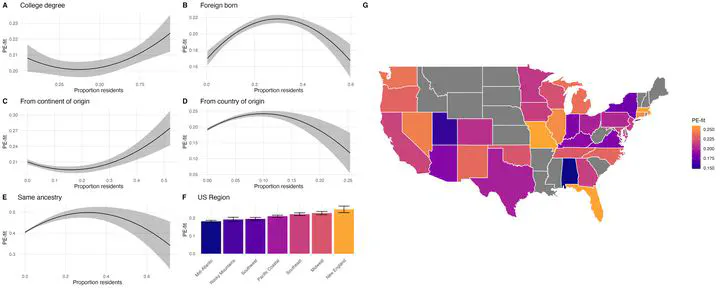Person-environment fit among U.S. immigrants: Associations with well-being and health

When we think about what helps immigrants thrive in a new country, we often focus on structural factors: access to jobs, housing, healthcare, and education. But there’s also a psychological dimension that’s been overlooked — person–environment fit (PE-fit), or how well someone’s personality aligns with the culture and norms of their community.
In other contexts — like education and workplaces — PE-fit is a consistent predictor of success. Students who “fit” their school do better academically and socially. Employees whose personalities match their organizations’ values tend to be more satisfied and productive. I wanted to know: Does the same hold true for immigrants settling in the United States?
How We Studied It
We drew on data from over 39,000 immigrants living in nearly 10,000 zip code tabulation areas (ZCTAs) across the U.S., comparing them to a sample of 122,000 U.S. natives. Each person completed a detailed personality survey.
We then calculated PE-fit by correlating an individual’s personality profile with the average profile of other people living in their ZCTA.
This gave us an “objective” measure of fit — how closely someone’s psychological characteristics match those of their neighbors.
What We Found
1. Immigrants generally had lower PE-fit than U.S. natives
On average, immigrants’ fit scores were smaller (around 0.23–0.35) than natives’ (0.47).
This might reflect the fact that many immigrants move for reasons unrelated to personality match — like safety, economic opportunity, or family — not because the community “feels” like them.
2. Certain characteristics predicted higher PE-fit
Immigrants fit better when they were:
- Older (fit increased steadily from adolescence to midlife).
- More educated.
- From Western countries, or countries where French or German is the official language.
They also tended to have higher fit if they scored high on traits like Honesty, Introspection, Creativity, and Industry.
3. The community itself mattered
Immigrants had better fit in ZCTAs where:
- More residents were college-educated.
- More residents were foreign-born — especially from the same world region.
- There was a moderate proportion of people from their exact ethnic background.
4. PE-fit was linked to well-being and health
Higher fit was associated with:
- Better self-reported health
- Higher well-being
- Lower stress
These effects held even after controlling for personality traits.
Why It Matters
These findings suggest that psychological fit with one’s community is more than a “nice to have” — it’s linked to tangible health and well-being benefits for immigrants.
But PE-fit isn’t simply about assimilation. It could reflect integration — retaining one’s original culture while engaging with the new one — which research shows is linked to better mental health.
It also highlights how community composition can help. Living near others with shared experiences can boost both objective fit and well-being, possibly by providing social support, familiar cultural cues, and easier access to resources.
Looking Ahead
Future work needs to unpack why PE-fit benefits health:
Is it because the environment feels more welcoming?
Because daily life is easier to navigate?
Or because fit encourages deeper social ties?
Understanding these pathways could inform policies that help immigrants settle in communities where they can flourish — psychologically as well as materially.
Takeaway: Where you live — and how well it aligns with who you are — matters.